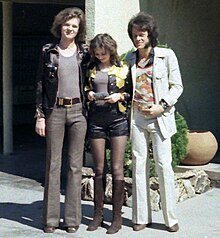


Fashion in the 1970s was about individuality. In the early 1970s, Vogue proclaimed "There are no rules in the fashion game now"[1] due to overproduction flooding the market with cheap synthetic clothing. Common items included mini skirts, bell-bottoms popularized by hippies, vintage clothing from the 1950s and earlier, and the androgynous glam rock and disco styles that introduced platform shoes, bright colors, glitter, and satin.[2]
New technologies brought advances in production through mass production, higher efficiency, generating higher standards and uniformity. Generally the most famous silhouette of the mid and late 1970s for both genders was that of tight on top and loose on bottom. The 1970s also saw the birth of the indifferent, anti-conformist casual chic approach to fashion, which consisted of sweaters, T-shirts, jeans and sneakers.[3] One notable fashion designer to emerge into the spotlight during this time was Diane von Fürstenberg, who popularized, among other things, the jersey "wrap dress".[4][5] von Fürstenberg's wrap dress design, which was among the most popular fashion styles of the 1970s, would also be credited as a symbol of women's liberation.[6][7] The French designer Yves Saint Laurent[8][9] and the American designer Halston both observed and embraced the changes that were happening in the society, especially the huge growth of women's rights[10] and the youth counterculture. They successfully adapted their design aesthetics to accommodate the changes that the market was aiming for.
Top fashion models in the 1970s were Lauren Hutton, Margaux Hemingway, Beverly Johnson, Gia Carangi, Janice Dickinson, Patti Hansen, Cheryl Tiegs, Jerry Hall, and Iman.


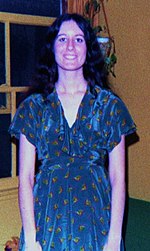


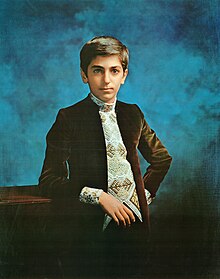
|
Main article: peacock revolution |

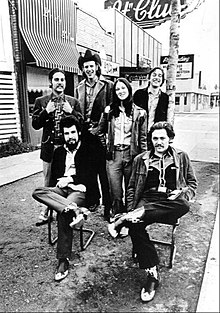
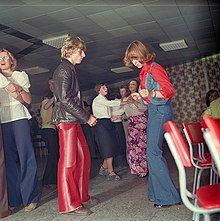
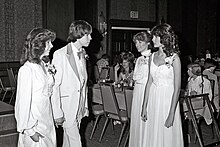


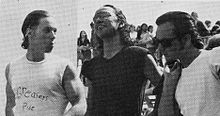

Throughout much of the decade, women and teenage girls wore their hair long, with a centre or side parting, which was a style carried over from the late 1960s. Other hairstyles of the early to mid-1970s included the wavy "gypsy" cut, the layered shag, and the "flicked" style, popularly referred to as "wings", in which the hair was flicked into resembling small wings at the temples. This look was popularised by the stars of the television series Charlie's Angels. Blonde-streaked or "frosted" hair was also popular. In 1977, punk singer Debbie Harry of Blondie sparked a new trend with her shoulder-length, dyed platinum blonde hair worn with a long fringe (bangs).
In the 1970s, making one of the popular hairstyles for a woman didn't take a lot of time. These hairstyles, including Afro hairstyle, Shaggy Hairdo and Feathered hair (then known as "Farrah Fawcett hairstyle") were said to be perfect when you're on-the-go and would still keep your expressive style in-check.[412] For black people in the United States and elsewhere, the afro was worn by both sexes throughout the decade. As the Afro entered the mainstream, Afro-enhancing products and Afro wigs emerged in the African-American beauty industry.[413] These wigs were created and advertised as a bolder look that could conveniently be removed and put on for a night out.[413] For Black women, it became a staple in disco, with disco divas like Diana Ross and Gloria Gaynor adopting it in the 1970s. Afros were also occasionally sported by Whites, especially Jewish Americans[414] as an alternative to the uniform long, straight hair which was a fashion mainstay until the arrival of punk and the "disco look" when hair became shorter and centre partings were no longer the mode.
The most iconic women's hairstyle of the 1970s is arguably the Farrah Fawcett hairstyle. Popularized in 1976, the hairstyle was heavily imitated by many American women and girls. It incorporated waves, curls, and layers. The style mostly worn with bangs, but could also be worn with a side part. To make it even more stylish, women and girls would frost their hair with blonde streaks.[415]
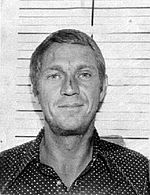

Continuing on from the 1960s, the ducktail and Pompadour hairstyle (then known as the "Elvis Presley hairstyle") were popular among young Italian-American and Mexican-American men in big cities like New York. Large quantities of grease or brylcreem was normally used to keep the hair in place. The early and mid 1970s generally featured longer hair on men, as way of rebelling against the social norms of years past.[416] Sideburns were also worn around the same time. Some of the most popular hairstyles for men include "Long and Luscious" hairstyle, mod haircut, and the "buzzcut" hairstyle popularised by action heroes like Steve McQueen. In the late 1970s, men went for the chop, ranging from crew cuts, to buzz cuts, to a shag. This was mainly done for an athletic look, and sideburns and facial hair went out of style.
|
Main article: Cosmetics in the 1970s |

Cosmetics in the 1970s reflected the contradictory roles ascribed for the modern woman.[417] For the first time since 1900, make-up was chosen situationally, rather than in response to monolithic trends.[417] The era's two primary visions were the daytime "natural look" presented by American designers and Cosmopolitan magazine, and the evening aesthetic of sexualized glamour presented by European designers and fashion photographers.[417] In the periphery, punk and glam were also influential. The struggling cosmetics industry attempted to make a comeback, using new marketing and manufacturing practices.
Images representing the fashion trends of the 1970s.